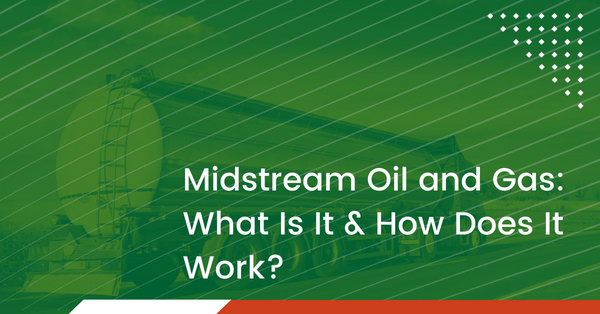What are Midstream Oil and Gas Operations?
Midstream refers to the transportation, storage, and wholesale marketing of oil, natural gas, and natural gas liquids (NGLs). It is the stage of the oil and gas value chain between the upstream (production) and downstream (refining and marketing) segments.
Midstream activities include pipeline transportation, storage facilities, natural gas processing, and NGL fractionation. Midstream operations aim to ensure the efficient movement of oil and gas from production sites to the end user.
Oil companies combine upstream, midstream, and downstream activities in their operations so they can maximize their production of oil and gasoline.
Midstream Customer Challenges
Compliance
Various government agencies regulate the transportation of oil and gas products, and compliance with these regulations is critical. Your 3PL provider should thoroughly understand industry regulations and comply with all applicable laws and standards.
Safety
The transportation and handling of hazardous materials in the midstream sector require a focus on safety. Again, your 3PL provider must have a strong safety program to comply with industry regulations and standards.
Real-time Visibility
Customers in the midstream sector expect real-time tracking and monitoring capabilities, allowing them to track shipments and monitor delivery status in real-time.
Using a Transportation Management System
The logistics behind midstream gas and oil operations pose a unique challenge. While there is an obvious need to transport hazardous material, there is an additional need for real-time tracking and visibility of shipments.
The customer tracking portal in a transportation management system will give you visibility into your product flow and show you all the tracking updates on a map. You will see the location of your shipment and get updates on it. A TMS also gives additional supply chain visibility to your customers. You can keep them posted on the shipment’s flow by sending instant notifications and updates generated through TMS. It will represent you as a reliable shipper that prioritizes clients’ needs and shares control over the shipment.
Additionally, a TMS gives you the ability to identify service disruptions. You will have the advantage of quick updates so adjustments can be made. Tracking information can also be used for creating efficient route schedules.
Ways to Ship Oil and Gas
Trucks
Trucking provides the oil and gas industry’s most accessible and utilized form of transportation. With over-the-road transit, you can schedule product shipments and transport them anywhere. This advantage makes trucking, perhaps, more beneficial than other transportation modes. Also, the risk of damage, such as cracks or leaks, is relatively small due to the low volume of oil carriers can transport.
Additionally, several types of trucks can perfectly suit the needs of the industry.
- Flatbeds allow you to move loads of any size and shape because of their open trailers. Rigs, pipes, and drilling equipment are usually oversized and overweight, which makes it difficult to move using any other transportation method except a specialized truck. You won’t have to worry about placing a large item into flatbeds since their space allows you to accommodate the objects without the threat of damage.
- Hotshots are trailers connected to a pick-up truck carrying small and urgent shipments. A hotshot is an ideal option whenever you quickly transport a piece of equipment to a remote site. You can also consider using hotshots in multimodal shipments when delivering parts of your cargo to several destinations.
- Oil tankers are special cylindrical containers connected to trucks. While tankers usually move liquids, they are also capable of moving oil. Although you cannot ship a large volume of oil through the truck, the vehicle can take it to any destination you need.
Pipelines
This transportation method is relatively basic; oil is gathered and transported directly to the site or plant via a pipeline network. It is a fast and reliable way to distribute oil. Modern technology has also aided the advanced safety of this mode, with pipelines now equipped with sensors for monitoring important indicators like temperature and pressure.
Pipeline transportation does have its disadvantages. Shipping destination limitations exist due to the lack of pipeline infrastructure. Additionally, because pipelines move enormous amounts of oil, the resulting damage can be severe if an accident occurs.
Ocean
While typically used as one part of a sizeable intermodal strategy, ocean shipping is a slow but inexpensive, reliable way to move vast volumes of fuel. Tank vessels, typically used for ocean transportation of oil and gas, demonstrate high protection levels to prevent leaks. However, ocean delivery requires more time and additional labor due to the large size of these transportation units. Ocean transportation offers a significant advantage over other shipping methods to those transporting materials globally despite longer transit.
Rail
Rail transport had been the primary way to move oil for more than 150 years. Today though, it is best used with other shipping methods to add transportation flexibility. Rail remains hugely beneficial as a fast and cost-effective way to move oil long-distance. It gets even more helpful when shipping oil and gas internationally since rail transportation is highly compatible with multimodal shipments. Rail oil containers are also less prone to damage compared to other shipping modes.
Oil and gas shipping with PLS Logistics Services
At PLS Logistics Services, we have more than 30 years of experience providing logistics services for oil and gas companies across North America. We understand the importance of choosing the correct mode of transportation and can enhance your business’s transportation strategy with our customized solutions, 55,000 carrier network, and various methods. Get a free oil and gas shipping quote today!


